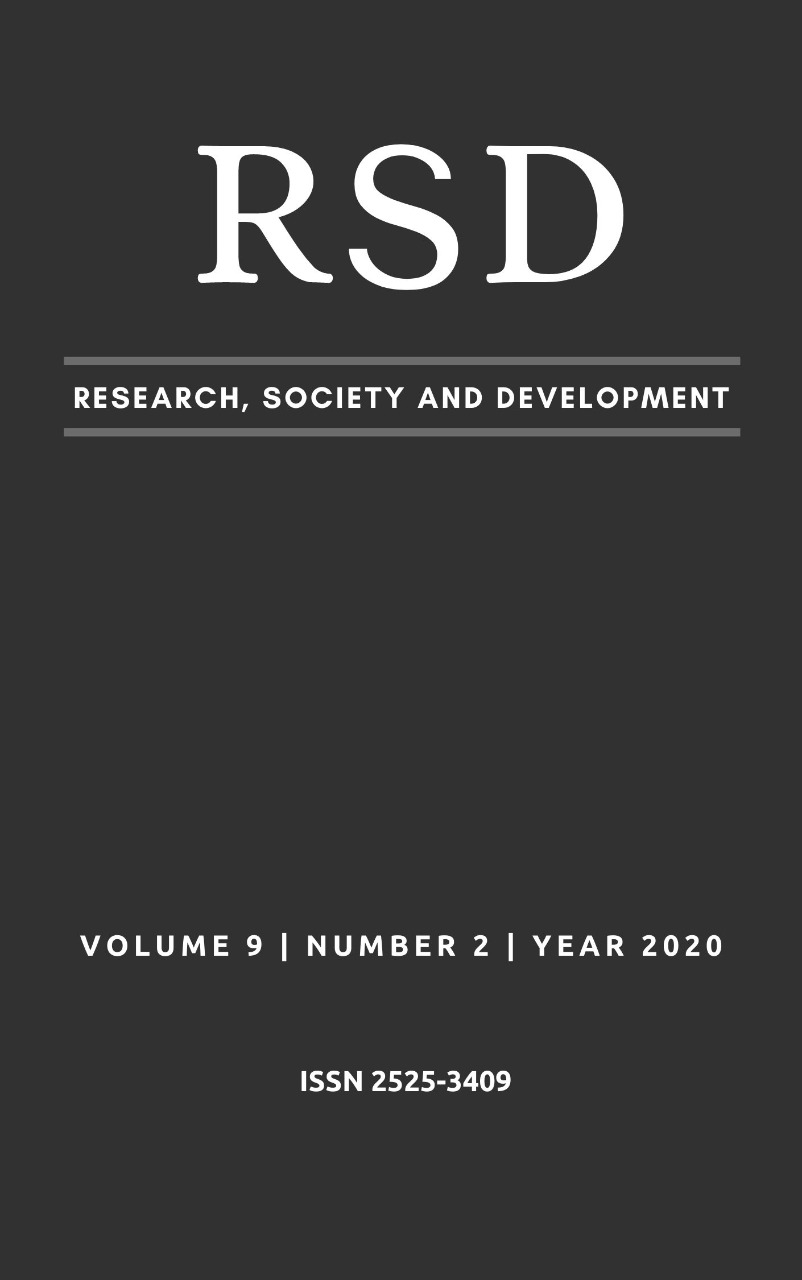Avaliação da percepção dos alunos da UFCG sobre o ensino da ortodontia no período da graduação
DOI:
https://doi.org/10.33448/rsd-v9i2.2138Palavras-chave:
Ortodontia, Epidemiologia, Má oclusão.Resumo
Identificar a contribuição do ensino da Ortodontia, no curso de graduação em Odontologia da Universidade Federal de Campina Grande, na formação do profissional generalista de acordo com as propostas das Diretrizes Curriculares Nacionais. Foi realizado um estudo observacional, transversal e exploratório, através de um questionário aplicado a 77 alunos dos 9º e 10º períodos. Para 64,9% dos alunos, as metodologias de ensino empregadas na disciplina de Ortodontia durante a graduação foram consideradas muito eficientes para o aprendizado, porém, 58,4% consideraram necessário um aumento no tempo destinado a disciplina devido ao extenso conteúdo prático da mesma. (94,8%) se sentem capazes de realizar recuperação de espaço por perda precoce de dentes decíduos e/ou manter o espaço da perda até erupção do permanente, (51,9%) se consideram aptos a tratar mordida aberta anterior, na expansão lenta da maxila (mordida cruzada posterior) (33,8%) responderam que podem tratar e (32,5%) consideram ser capazes de realizar disjunção (expansão rápida da maxila) em todos os casos e (49,4%) em alguns. Em procedimentos mais complexos na Ortodontia, como a correção da má oclusão classe III com máscara facial, apenas (11,7%) relatou ser capaz de realizar tal procedimento. A disciplina de Ortodontia do curso de graduação em Odontologia da UFCG contribui de forma satisfatória na formação de profissionais aptos a realizar procedimentos ortodônticos preventivos e interceptativos necessários as demandas de um generalista em âmbito privado e/ou público segundo as DCN, necessitando apenas de mais tempo na grade curricular para fornecê-los maior autonomia na realização de procedimentos ortodônticos mais complexos.
Referências
Barroso, MCF (2012). Percepção dos alunos sobre o ensino da ortodontia na graduação e na formação do clínico geral.
Behrents, RG; Keim, RG (1991). Education, research, and personnel needs in orthodontics. Curr Opin Dent, 1 (5), 652-656.
Brasil. (2002). Ministério da Educação. Diretrizes Curriculares Nacionais dos Cursos de Graduação em Farmácia e Odontologia. Parecer CNE/CES nº 1.300/01, aprovado em 6 de novembro de 2001. Brasília: Ministério da Educação.
Brizon, VSC et al (2013). Fatores individuais e contextuais associados à má oclusão em crianças brasileiras, Rev. Saúde Pública, 47 (Suppl 3), 118-128.
Carvalho DM, Alves JB, Alves MH (2011). Prevalence of malocclusion in schoolchildren with low socioeconomic status. Rev Gaucha Odontol, 59 (1), 71-77.
Castro, R. G. (2012). Diretrizes para a atenção às oclusopatias no sistema único de saúde.
Dowling, P., & Oliver, R. (2000). Undergraduate orthodontic education in Europe. British Journal of Orthodontics, 27 (2), 187-188.
Faltin Junior, K.; Faltin, R. M. (1997). Ortodontia preventiva na saúde bucal. In ABOPREV promoçäo de saúde bucal (pp. 349-61).
Gecker, LM; Weil, RB (1970). Undergraduate Orthodontic Education. N Y J Dent, 40 (8), 281-282.
Guzzo, SC (2012). Ortodontia preventiva e interceptativa na rede de atenção básica do SUS: perspectiva dos cirurgiões-dentistas da Prefeitura Municipal de Florianópolis.
Jacobs, RM (1977). Ten-year study of strategies for teaching clinical inference in predoctoral orthodontic education. J Dent Educ, 41, 477-478.
Järvinen, S. (2001). Indexes for orthodontic treatment need. American Journal of Orthodontics and Dentofacial Orthopedics, 120(3), 237-239.
Lopes-Monteiro, S.; Nojima, M.C.M.; Nojima, L. I. (2010). Ortodontia preventiva x ortodontia interceptativa: indicações e limitações. Jornal Brasileiro de ORTODONTIA & Ortopedia Facial, 8(47).
Maciel, S. M.; Kornis, G. E. M. (2006). A ortodontia nas políticas públicas de saúde bucal: um exemplo de eqüidade na Universidade Federal de Juiz de Fora. Physis: Revista de Saúde Coletiva, 16, 59-81.
Masetto, M. T. (1998). Discutindo o processo ensino/aprendizagem no ensino superior. Educação médica.
Brasil. (2011). Ministério da Saúde. SB Brasil 2010- Pesquisa Nacional de Saúde Bucal. Resultados Principais. Brasília: Departamento de Atenção Básica, Secretaria de Atenção Básica, Ministério da Saúde; 2011.
Nóbrega, J. S. M.; Teixeira, J. A. T (2006). Estudo de prevalência da cárie dentária, má-oclusão e hábitos bucais deletérios em pré-escolares assistidos pelo PSF visando à reformulação das ações em promoção de saúde bucal [citado em 2006 Jun 20].
Oliveira, C. M., Sheiham, A. (2004). Orthodontic treatment and its impact on oral health-related quality of life in Brazilian adolescents. Journal of orthodontics, 31 (1), 20-27.
Richardson, A. (1997). Undergraduate orthodontics in Belfast: 12 years on. European Journal of Dental Education, 1 (3), 133-137.
Silva Filho, O. G. D.; Freitas, S. F. D.; Cavassan, A. D. O. (1990). Prevalência de oclusão normal e má oclusão em escolares da cidade de Bauru (São Paulo). Parte I: relação sagital. Rev. Odontol. Univ. São Paulo, 130-7.
Spengeman, WG (1955). O dilema da educação ortodôntica na graduação e seus efeitos. American Journal of Orthodontics and Dentofacial Orthopedics, 41 (10), 765-777.
Tomita, N. E., Bijella, V. T., & Franco, L. J. (2000). Relação entre hábitos bucais e má oclusão em pré-escolares. Revista de Saúde Pública, 34, 299-303.
Van der Linden, FPGM (1992). Programa de Pós-Graduação Três Anos em Ortodontia: Relatório Final: Projeto Erasmus. Revista Britânica de Ortodontia, 19 (3), 242-250.
Downloads
Publicado
Edição
Seção
Licença
Autores que publicam nesta revista concordam com os seguintes termos:
1) Autores mantém os direitos autorais e concedem à revista o direito de primeira publicação, com o trabalho simultaneamente licenciado sob a Licença Creative Commons Attribution que permite o compartilhamento do trabalho com reconhecimento da autoria e publicação inicial nesta revista.
2) Autores têm autorização para assumir contratos adicionais separadamente, para distribuição não-exclusiva da versão do trabalho publicada nesta revista (ex.: publicar em repositório institucional ou como capítulo de livro), com reconhecimento de autoria e publicação inicial nesta revista.
3) Autores têm permissão e são estimulados a publicar e distribuir seu trabalho online (ex.: em repositórios institucionais ou na sua página pessoal) a qualquer ponto antes ou durante o processo editorial, já que isso pode gerar alterações produtivas, bem como aumentar o impacto e a citação do trabalho publicado.


